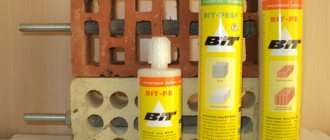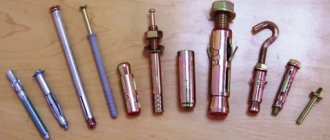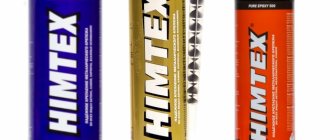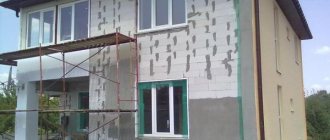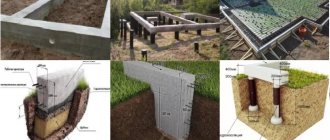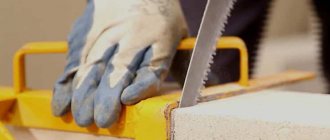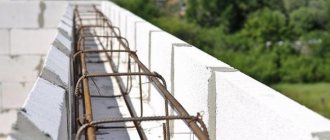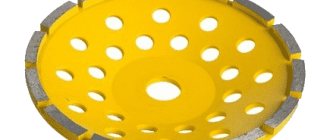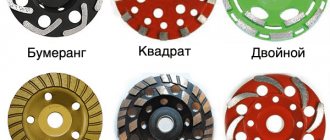Aerated concrete block is porous, making it a very lightweight building material. Air is a good heat insulator, so aerated concrete houses are very warm in winter and allow you to keep cool inside in summer. However, due to the fact that this material has different densities throughout its entire volume, mounting lamps to the wall and other interior elements most often does not come without problems. In this case, classic building materials, such as all types of brick and concrete, look more advantageous. But don’t rush to get upset, read the article to the end and learn everything about fasteners in aerated concrete, as well as what fasteners to use for aerated concrete.
When mounting, for example, a chandelier, cabinet or TV, you may encounter the following problems:
- Self-tapping screws or dowels can be loosened or removed after screwing in with a little effort;
- Even if everything went well during installation, over time, due to vibration and load, your favorite interior element may fall and become unusable.
Each of you can face all this. Almost immediately after the invention of aerated concrete blocks, it became clear that special fastening elements were needed. We invite you to familiarize yourself with them in more detail.
Anchors and dowels are classified as follows:
- Two-part screws and nails, which use classic elements together with polymer dowels that wedge inside when tightened. Their main difference from simple expansion screws is that the hardware is divided into four parts with two sections, making installation easier and operation more reliable.
- Facade dowels are used to install profiles in order to subsequently cover the house with cladding panels or siding.
- The universal dowel for aerated concrete walls has a longer length and transverse notches compared to its predecessors. When fastening the elements, the hardware inside the wall is twisted, which increases the reliability of the fastening.
- Screw metal and screw nylon dowels differ in design and installation principle. The first does not require a spacer part, since during the screwing process the thread is “cut”, on which the dowel is held. The second type has a sleeve-like shape, tapering towards the end, which allows you to securely fasten relatively light elements, such as a suspended ceiling or suspended household appliances.
- The most reliable and at the same time expensive is the anchor fastening. It is used for the installation of elements of significant weight: heating tanks and air conditioners.
It is important to understand that there are many types of fasteners. You just have to remember that good hardware should be long and, during installation, should be wedged in at least four directions, and preferably even around the circumference. This way the fastening will be reliable, and your confidence in it will be absolute.
Fastening building structures to aerated concrete
On such fragile walls it is necessary to fix not only wires and pipes, but also heavy structures: floors, roofing elements, etc.
In such cases, fixing self-tapping screws into aerated concrete is not a solution; a serious decision is needed. As a rule, it is carried out during the process of laying walls, when a monolithic reinforced concrete armored belt is made at the installation level of such structures. During pouring, studs and other embedded parts are installed into it, onto which the fastening is subsequently carried out.
If for some reason you did not make an armored belt, or did not provide mortgages in it, fastening is carried out only with chemical anchors.
Features of fastening to an aerated concrete block
Due to their porosity, aerated concrete walls are quite fragile, as a result of which fastening anything becomes difficult or even impossible. In this case, fastening occurs using a dowel. First, the hole is prepared - a hole is drilled to fit the dimensions of the fastener. Then the dowel is inserted and a screw is screwed into it or a nail is driven into it, which leads to the expansion of the dowel inside the hole. After this, removing the dowel without damaging a large section of the wall is already problematic.
As you can see in the picture, the screwed dowel is firmly fixed inside and does not allow the screw to be pulled out of the hole.
When choosing fastenings for aerated concrete walls, take into account such features
When choosing hardware, take into account the strength of the working surface, the dimensions of the parts and their resistance to corrosion.
The higher the density of the material, the stronger the aerated concrete. This indicator sets the load limits on the fastener. Technical characteristics in digital terms are indicated on the packaging of building blocks after the letter D.
The strength of the connection is affected by the size of the dowels. Thus, when fixing massive structures, products of large diameters and lengths are used.
The resistance of fasteners to corrosion ensures the possibility of their use when installing external structures and arranging unheated premises.
Features of installing a power plate without installing an armored belt
Reinforcement is not always carried out, so it is important to know how to properly fasten the Mauerlat to aerated concrete without installing an armor belt. This is possible subject to the following conditions:
- There should be no additional load on the upper edge of the wall from the rafters.
- The roof should be installed so that the slopes are minimally affected by wind load;
- The rafters and mauerlat should not create additional pressure on the upper edge of the wall under the influence of snow load.
It is important to decide in advance on the method of attaching the Mauerlat, even before the walls are erected. This affects how the top three rows of masonry will be laid out. It is here that the reinforcement is laid, with which you can fix the beam on the gypsum concrete wall.
Scope of application
Chemical anchors in aerated concrete are used less frequently. It is used in cases where it is necessary to provide reliable fastening for massive objects. Mechanical anchors are not capable of supporting, for example, the weight of massive equipment.
Epoxy compounds are used mainly on solid bases. They are used for fastening:
- wall structures;
- beams;
- fences along roads;
- creating noise-insulating screens;
- when installing reinforcement outlets;
- when installing attachments.
This composition can be used:
- in a humid environment;
- under the water;
- both outside the building and for interior work.
Its composition:
- does not create stress in the structure of the porous wall;
- does not contain styrene;
- creates fastenings with smooth reinforcement.
The hardening of the mass depends on the air temperature. The time can last from 7-180 minutes. or 7-48 hours.
Polyester anchors are used to create:
- enclosing structures;
- when installing façade elements;
- for installation of translucent elements;
- during installation of utilities.
Typically, threaded rods are installed along with polyester compounds. The polyester anchor does not contain styrene. Therefore, it can be used on interior and exterior fasteners. The polyester anchor takes from 2 to 30 minutes to set and hardens from 25 to 180 minutes.
The anchor bolt for aerated concrete can be smooth or threaded if a vinylester anchor is used. It is used to create fasteners in wet substrates. It does not create unnecessary stress in the structure of aerated concrete. This adhesive solution is safe because it does not contain harmful substances. It is used for making internal and external fasteners. Does not create stress after installing fasteners in the structure of the aerated concrete block. Hardening is observed after 15 minutes or a day.
Epoxy acrylate anchor composition has become more widely used due to its properties. The period of setting and hardening of the composition is 2-24 and 15-180 minutes, respectively. Epoxy acrylate retains its properties when the temperature drops to -5°C, and also resists fire in case of fire for up to 2 hours. Epoxy acrylate anchor composition is suitable for anchoring floor slabs in aerated concrete houses.
How to choose the best type of fastening
The choice of optimal fasteners for aerated concrete must be made after a thorough analysis of the upcoming loads, as well as an examination of the load-bearing surfaces. In addition, it is necessary to take into account the weight of the kitchen set and related equipment, its configuration and operating features.
When choosing the type of fastener, you must first consider the load vector. There is hanging furniture that creates a shear load. If it is static, i.e. There are no jerks or vibrations, then you can limit yourself to elements designed for small or medium loads. However, for mounted or suspended devices with variable loads, as well as with efforts aimed at tearing, powerful anchor elements are needed - chemical, or acting on expansion. It is important to follow the installation technology and use drills of the correct diameter. When installing chemical anchors, you should first carefully study the instructions and strictly follow them during the installation process.
As a rule, threaded fasteners (anchors) are used for hanging appliances, gas boilers, ventilation and other items that require strong and immovable fixation on the walls. These devices are usually installed once and for all, therefore, fasteners of this type are the most effective. For wall cabinets, shelves and other furniture, dowel fasteners with self-tapping screws as supporting elements are more suitable. They allow you to periodically remove cabinets to clean walls, perform cosmetic repairs or other work.
Why you shouldn’t attach excessively heavy structures to gas block and foam block
About the gas block
Autoclaved aerated concrete has thermal conductivity characteristics close to foam plastic because, like insulation, it contains air bubbles in its structure. At the same time, foam plastic has almost zero load-bearing capacity.
Why should a gas block be so much more durable? It should be noted that it copes well with a load evenly distributed over an area, for example, in wall masonry. But it does not tolerate local loads from ordinary dowels and anchors, that is, it simply does not hold
And no matter what the manufacturers of such blocks say, you need to load the material locally with great care - use special fasteners, spread them over a large area, do not hang very heavy structures without a metal frame
Excessive load on aerated concrete can lead to similar consequences
The weakest point of an aerated block in terms of load-bearing capacity is variable pressure. Periodically attaching and removing any heavy structure from an anchor will contribute to the crumbling of the material around the fastener and failure of the attachment point.
About the foam block
Foam concrete is used less frequently in modern construction, and on average it is heavier and stronger than aerated concrete. Of course, strength depends on the class of the material - the higher the class, the more durable it is, but at the same time it loses somewhat in its heat-insulating properties.
Perhaps we can say that the foam block is somewhere between concrete and aerated concrete in terms of strength. However, when choosing an anchor for foam concrete, it is better to be guided by the same principles that apply when using aerated concrete.
Requirements for siding installation
It is worth noting that under the influence of temperature, siding contracts and expands, that is, soffits constantly change their size. It follows from this that if you fasten the siding to the sheathing rigidly, it will begin to warp (bend).
Therefore, please observe the following instructions:
- The siding and auxiliary strips should be attached exactly to the center of the mounting hole.
- Leave a gap of a millimeter between the head of the fastening screw and the siding so that the siding has the opportunity to expand and contract.
Characteristic
Aerated concrete is rightfully recognized as one of the most practical and affordable materials. It makes durable and strong houses, as well as reliable outbuildings. However, you need to take into account that this material has a cellular structure, when faced with which you need to take into account many nuances. The main characteristic feature of this material is its fragility and pliability. Porous blocks can be trimmed or cut off the excess part without any extra effort. And we must also not forget that special fasteners are used for such a structure. Traditional fasteners, as a rule, do not adhere well to such foundations, which is why the whole point of their use is lost.
For aerated concrete, special dowels should be used. The design of such parts is a sleeve in the form of a spiral, on the surface of which there are ribs. When screwing in a self-tapping screw, the last elements become wider, so they fit firmly into the loose aerated concrete surface. This simple but effective device can easily withstand impressive loads. With the use of special dowels, home owners have the opportunity to hang heavy decorative objects of any size on the walls.
Modern manufacturers produce these types of dowels in two variations. They differ in design features.
- According to the shape of the fixation ribs. Such fasteners can be equipped with a classic helical spiral or have cone-shaped ribs. The edges of the latter may resemble spiral-like blades.
- By installation method. The dowels are either screwed into the base or driven into it. Screw-in types are considered to be the most reliable. It is recommended to use driven-in fasteners if the aerated concrete floor is planned to be equipped with a collet.
Fastening building structures to aerated concrete
In general, the process of installing fasteners is similar for all options. First of all, a hole is made, and then the cartridge is inserted. The only difference can be with a chemical anchor, since it uses glue.
Chemical anchors are secured as follows:
- Preparatory work. You need to drill a hole using a drill.
- Next, the hole needs to be cleaned of dust. To do this, use a brush or a medical bulb.
- A cartridge with a chemical composition is installed. To do this, you need to insert a capsule with glue into the recess. The last one is squeezed out.
- An anchor is screwed into the hole.
- You need to wait until the glue dries. There are times when you need to wait 2 days for complete drying. It all depends on the composition, but temperature, humidity and other environmental features are also considered important factors.
- Once the compound has hardened, you can install the washer and nut.
The installation process using a mechanical anchor, dowel nail or self-tapping screw is the same, but without the use of glue.
This is what the fastening looks like inside aerated concrete.
Video on the topic:
Each fastening method has its own advantages and disadvantages. When choosing, you should take into account the material, density, and characteristics of the room.
Previous entry How to attach a window sill to a plastic window Next entry Features of attaching gates to brick pillars
Methods for fixing the Mauerlat to a wall made of aerated concrete
There are several options for attaching a roof to a gas block. The support beam is installed according to a pre-selected pattern. The beam can be attached not only mechanically, but also using an adhesive method. In the corners of the building, the element is fixed using corners, metal plates, and forged brackets.
Steel wire
To fix the Mauerlat, wire clamps made of annealed steel wire with a cross-section of 4 to 6 mm are used. This method is suitable for walls with or without reinforced belt. If there is an armored belt, then the wire is attached to the longitudinal reinforcing bars. If there is no armored belt, then the clamps are placed in the masonry. The pitch of the elements along the perimeter of the building is 500 - 700 mm. In this case, the wire should protrude above the support beam by no less than 300 - 500 mm. When the Mauerlat is laid, the wires are tied together using a crowbar or pry bar to rotate the ends of the loops. Then they are pressed tightly against the beam.
On metal rods (studs)
A metal pin is a steel rod with a diameter of 10 to 16 mm with a metric thread. When installing a gable roof, the embedded elements are installed by welding, when the frame is welded. Also, reinforcing bars are connected to embedded parts using binding wire.
If there is no monolithic belt when installing the Mauerlat, then a metal plate measuring 10 x 10 cm and thickness from 1.8 to 3 mm is welded to the lower part of the element. The part is placed inside the masonry to a depth of 40 to 60 mm. As a result, the top of the rod should protrude above the surface of the beam to a height of 30 - 50 mm.
Expert opinion Vitaly Kudryashov builder, aspiring author
Ask a Question
If the studs are installed inside a finished monolithic base or solid masonry made of aerated concrete blocks, then holes are made for them in increments of 120–150 cm to a depth of 200–300 mm.
Holes are marked on the surface of the timber by lowering it onto the protruding rods and pressing lightly so that they leave marks on the wood. Then holes are drilled according to the markings, and the timber is placed on metal pins. The element is fixed at the top using washers and nuts. Connections are tightened after the location of the element has been checked. When installing the Mauerlat in this way, take into account that the number of studs should be equal to the number of rafter legs.
Adhesive installation
An alternative to the mechanical method of fastening the Mauerlat is adhesive installation. The composition of such an anchor includes composites, a metal rod equipped with threads, a washer, and a nut.
In a reinforced belt, you first need to drill a conical or cylindrical hole. After this, the solution is pumped into the holes using a special device and the timber is laid. Then metal rods are immersed through it.
When the adhesive composition has hardened, on average it should take 30 - 40 minutes, the beam can be tightly secured with washers and nuts.
Mechanical anchor
When connecting the timber to the base using anchor bolts, a reliable rigid connection is ensured. The horizontal displacement of the element is eliminated, so the thrust forces of the rafters are transmitted evenly to the walls.
Expert opinion Vitaly Kudryashov builder, aspiring author
Ask a Question
This fastening method is suitable in the presence of a monolithic belt and in its absence. In the first case, holes are drilled in the armored belt, in the second case - in the masonry. In this case, the size of the hole should be slightly larger than the spacer element - so that the threaded coupling fits into it. The same holes are drilled in the timber. It is laid on top so that the holes coincide and anchor bolts are passed through the beam. The connection is tightened using a wrench.
Dowel
The part is a spiral-shaped bushing with ribs on the surface. At the moment the screw is screwed in, they expand, due to which they firmly fit into the soft surface of the base. Such fasteners can be made of galvanized steel or plastic.
The first option is the most common and is considered the most expensive. It is used when installing profiles, installing attachments and furniture, and fixing various pipelines. Such fasteners have become widespread in fire-hazardous spaces.
Metal dowels for aerated concrete are produced in 2 modifications, which differ in design features and installation methods. The parts can either be screwed into the base or driven into it. The latter option is used if the aerated concrete floor is planned to be equipped with a collet.
Based on the shape of the fixation ribs, fasteners with a classic helical spiral and dowels in the form of a cone, equipped with spiral blades, are distinguished. The design of metal elements also provides for the presence of a locking flange or cuff, thanks to which the part will not rotate.
Corrosion resistance is the main advantage of plastic products. The materials used for them are polypropylene and polyethylene. The positive characteristics of the parts include their efficiency, environmental friendliness, and immunity to aggressive environments. Such dowels are not intended for outdoor work, since with the onset of cold weather the plastic may burst.
A separate group consists of fasteners for aerated concrete made of nylon. They are more wear-resistant, so they can be used for cladding facades. Together with them, galvanized screw elements with 2 types of heads are used - countersunk or hexagonal. The disadvantage of this type of fastening is the high price.
Depending on the scope of application, there are several types of dowels:
- Universal. It can be mounted in any concrete surface. In a solid base, fixation occurs in a standard way. In a cellular coating, the product is rolled into a persistent knot. However, the load-bearing capacity of universal dowels is lower than that of spacer elements.
- A dowel-nail that has a wide range of applications. At the moment of fixation, a nail is inserted into the fastener, rather than a screw being screwed in. In order to avoid turning the part, use a sleeve.
- The “pancake-like” structure of the frame dowels allows you to reduce the load on the porous surface of the block.
Tool and surface features
Installation tools:
- electric hand drill;
- drill bit with pobedite tip;
- hammer;
- a wrench or screwdriver for screwing in a screw;
- adhesive mixture for chemical anchor;
- special gun for glue mixture.
The main condition when installing objects and accessories is the correct choice of hardware.
Aerated concrete, having a porous structure, is a relatively fragile material, so the question arises - what kind of hardware is needed to ensure that the fastening is reliable and meets all the operating requirements of the structure.
There is a wide range of products that make it possible to fasten structures reliably and quickly.
From the video below you will learn about fasteners for aerated concrete.
Why does foam concrete need special fasteners?
Foam blocks are made from water, sand, cement and a special foaming agent. The blocks are cellular, the material is fragile enough for installation of various fasteners.
The main distinctive features of foam blocks: low weight, low density, high level of hygroscopicity, porous structure. For the most part, properties act as advantages during the construction and operation of buildings, but not at the moment of attaching some objects to the walls.
The structure of foam concrete is porous, the adhesion to materials is not very good, so the blocks cannot always cope with the loads, and therefore special dowels are provided for them.
Properly selected fasteners for foam blocks will not only secure equipment or furniture with high quality, but will also strengthen the working structure and significantly increase the percentage of permissible loads.
Fasteners for foam blocks require a certain design of fixing parts - they usually consist of the following elements: a screw, a ring, a half-ring, a side, an empty sleeve with a spacer. Many anchors are made with teeth, which become a reliable obstacle to the part turning.
There are also chemical anchors for foam blocks, which are created specifically for use and provide maximum quality of fastening. In this case, the main task of the dowel is to create internal support in the block during the expansion process inside the aerated concrete and preserve the fragile material from destruction.
Dowels can be of different diameters and lengths, made of metal or plastic, and are supplied in packs of 50-1000 pieces. According to the scope of application, they are intended for external/internal work, according to the installation method - driven, screwed and others (chemical anchors are distinguished separately).
Why does aerated concrete not hold conventional fasteners?
Aerated concrete is a building material from the cellular concrete family. It was developed a little over 100 years ago, although it appeared in its current form much later. The developers' task was to solve two problems:
- reducing the weight of buildings, allowing you to save on the foundation;
- increasing the heat-saving qualities of the material, providing savings on heating.
Both problems were successfully solved by obtaining a porous structure. The mass of material is filled throughout its entire volume with small (2-4 mm) bubbles of carbon dioxide, thanks to which aerated concrete receives all its qualities, both positive and negative. The advantages of the material include:
- light weight, convenient for construction and transportation;
- smooth and precise geometry of aerated blocks, giving high quality masonry;
- ease of processing and trimming, allowing the production of additional elements with high speed and accuracy.
However, there are some disadvantages:
- aerated concrete does not withstand compression and tension loads well (conventional types of concrete can withstand enormous compressive loads and are unstable only to multidirectional forces);
- the material is hygroscopic, the pores are able to accumulate moisture, which is poorly removed back. In summer, this property causes the appearance of mold and mildew, and in winter there is a danger of freezing and destruction of aerated concrete due to frosty expansion of ice.
Both deficiencies affect the material's inability to hold fasteners. The porous structure makes the material brittle and reduces its strength. Regular nails or screws are held in place only until a load is applied to them. Any effort creates rocking movements, from which the sockets almost immediately expand, and the fasteners simply fall out. This creates serious problems when it becomes necessary to hang household appliances, heating appliances or kitchen cabinets on an aerated concrete wall. If the material gets wet, metal parts begin to rust, which negatively affects their performance. At the same time, sockets and holes for fasteners become points of penetration of moisture and require special treatment before installing attachments.
Due to the low density of aerated concrete and the complete lack of elasticity, nails, crutches and other driving elements cannot be used. When deciding how to hang furniture or appliances, these fasteners should be discarded immediately. The only acceptable use for nails is when hanging a lightweight frame, picture, or decorative piece. Any objects weighing more than 2-5 kg should be attached to special parts.
Chemical anchor
This type of fastening, such as a chemical anchor, is a fairly new and already in demand method. The builders appreciated it. Chemical anchoring has its advantages and disadvantages. The advantages of a chemical anchor include:
- high load capacity factor on fasteners;
- compliance with GOST, the chemical composition is safe and environmentally friendly;
- versatility, it is used for any building material;
- high resistance to weather fluctuations and low temperatures;
- low price when compared with steel anchors.
The disadvantages include:
- strict adherence to technology;
- purchase of special equipment, namely brushes, pumps, guns and drills;
- additional time for the chemical solution to harden.
Chemical fasteners for foam concrete include a threaded steel pin, maybe a special rod, a chemical mixture, and additional bushings.
Chemical anchor fastening sequence
- Use a drill to make a cylindrical hole. Then it needs to be shaped into a cone with an expansion in depth.
- The finished hole is thoroughly cleaned. You can use a pump for this.
- A centering sleeve is inserted into the base.
- A chemical solution is poured into the hole through the sleeve; a construction gun is used for this.
- The threaded rod (stud) is screwed in.
- Leave time until the chemical solution hardens completely.
The chemical anchor kit includes an easy-to-use package with a dispenser. Installation is easy, while achieving high structural strength.
Fastening chemical anchors
And so, for fastening light structures and decorative elements, ordinary self-tapping screws are quite suitable. They can be designed for working on wood or on cellular concrete. Nails for aerated concrete should have a wedge shape or a curved tip inside the concrete cavity.
For heavy structures, such as plumbing fixtures, kitchen cabinets, boilers, it is worth using foam concrete fasteners with wedging dowels. Reliable fixation is achieved precisely thanks to the internal stop. All hardware must be resistant to corrosion. This especially applies to mountings on an external wall.
Alternative ways to install kitchen furniture and equipment
There are other ways to hang kitchen cabinets or appliances. Most often, structures similar to plumbing frames for installations are used. These are support systems that represent a supporting frame with an emphasis on the floor and technological holes for installing fasteners. These frames do not have to be attached to the walls, but it is difficult (if not impossible) to ensure their stability using other methods. The advantage of this type of hinge is reliability, the ability to adjust the height of the frame to a given height, and high load-bearing capacity. In addition, you can use frames (or supporting slats) of different sizes to suit the existing set. The frame can be attached to the walls at randomly selected points where it is more convenient to install anchors. In a similar way, you can hang not only kitchen cabinets on aerated concrete, but also equipment or heating devices.
Tips and tricks
When installing dowels into a gas block, you cannot use a screwdriver, since this device runs on electricity, which makes it more difficult to control. Such a device can strip the thread by twisting the screw
When making a hole for dowels in a gas block, it is important to note that they should not be larger than their diameter. Otherwise, the fasteners simply will not hold securely in the base
The depth of the holes should be slightly greater than the length of the dowel. The tip of the screw must leave the dowel for the fastening to be as reliable as possible.
Many people, having become acquainted with dowels, begin to use them at any opportunity. However, experts do not advise using too powerful fastenings if you plan to hang hooks, pictures and other small items. For such purposes, simple plastic fasteners, the size of which is about 8 mm, are more suitable.
About fastening for aerated concrete - a nylon dowel and a metal dowel (crocodile), see the following video.
Types of fasteners and performance of work
The type of product is selected depending on the expected load:
- for fastening hanging mirrors or lamps, nylon dowels with a cross-section of up to 12 mm are suitable;
- when installing pipelines and bulky objects, choose metal parts;
- frame types of fastenings are used to fix window and door frames;
- universal facade dowels are used when installing external profiles for facing slabs;
- Only light objects are attached to wood screws - photo frames or decorative elements.
Installation is carried out in several stages.
In order for the products to fit tightly into the base, it is necessary to drill the holes correctly. To do this, it is best to use a hammerless drill or a hammer drill with the impact turned off. The drill should have a cross-section 1 mm smaller than the fastener itself. The only exception is steel hardware. For them, the hole will be reduced by 2 mm.
After cleaning the recess from concrete dust, install a dowel. The plastic fastener is screwed in using a screwdriver. Metal parts are driven into the mounting hole with a hammer. During the work, it is necessary to ensure that the product does not warp.
At the final stage, screw in a self-tapping screw or a standard mounting bolt. In this case, it is not advisable to use an electric tool, since when connecting to an aerated concrete block, the screw element may be damaged.
Fasteners for cellular concrete
Using ordinary wood screws, only very light objects such as photo frames can be attached to aerated concrete. In all other cases, special fasteners will be required.
Fastening requirements
When choosing which fasteners to use for aerated concrete, you need to consider the following points:
The density of wall blocks, indicated in product labeling by numbers after the letter D. The higher it is, the fewer pores in the material, and the stronger it is. The load limit when pulling out fasteners depends on this indicator, and the manufacturer’s instructions on the packaging contain this information.
The numbers show how many kilograms are in a cubic meter of material
The fastener parameters are its length and diameter. The larger they are, the greater the load it can withstand. The load-bearing capacity must also be indicated on the packaging or certificate.
Chemical anchors have the highest load-bearing capacity
Corrosion resistance. This parameter is especially important when fastening into aerated concrete is carried out from external walls or in unheated rooms. Steel hardware must be coated with a protective layer.
Punch for aerated concrete
Mounting options
Let's take a closer look at which aerated concrete fasteners are used most often.
Let's start with the traditional types:
| Image | Application |
| When a smooth steel nail enters the sleeve, its base opens and enters the material at an angle. Suitable for all types of concrete. |
| Universal façade dowel | Allows you to attach a profile to aerated concrete to fasten facade panels and hang wall cabinets and shelves. |
| Used only for small loads: fastening light shelves, curtains, baseboards, switches, cable ducts, etc. |
| Helps to fasten window and door frames and wall cabinets to aerated concrete. |
| Nylon dowel for aerated concrete | Special development for aerated concrete. It is used with conventional self-tapping screws when installing wooden and metal facade subsystems, windows, doors, suspended ceilings, sanitary equipment, and pipelines. |
| Designed for any cellular concrete, the scope is wide. |
| Solves the problem of how to attach heavy objects to aerated concrete: water heaters, air conditioners, hanging pipes, heavy wall cabinets, etc. |
All these elements may have other varieties that differ from the images shown in the table. For example, turbo dowels with self-tapping threads are made from nylon.
Turbo dowel FTP K
And made of galvanized steel - four-leaf toothed expansion dowels. Their segments move apart when the screw is screwed in, reliably biting into cellular materials.
Steel expansion dowel
As already mentioned, one or another hardware and fastening method are chosen depending on the expected load.
If you need to fasten aerated concrete shelves, you need to carefully drill at a right angle, insert a dowel into the hole and screw a screw into it.
Shelves with covered mounting on aerated concrete wall
- And to hang a light picture or install an electrical switch, a simple self-tapping screw screwed at an angle of 45 degrees to the wall is enough.
- If you need to securely fasten heavy equipment or install a metal entrance door, it is best to use chemical anchors.
When installed, they are capsules made of synthetic resins and organic polymers that seal holes in a wall made of aerated concrete, firmly holding a metal rod or threaded rod in it.
The advantages of such fastening include exceptional reliability and durability, the adhesive base is not susceptible to thermal expansion and resistance to aggressive environments.
No special qualifications are required for fastening with chemical anchors; everything can be done with your own hands.
For this:
- A hole of the required depth is drilled in the wall, its bottom is slightly expanded by oscillating movements of the drill;
- Construction dust is blown out of the hole, and a sleeve is inserted into its neck;
- The cavity is filled with adhesive solution using a mounting gun;
- An anchor rod is immediately installed into it;
- After the solution has hardened, fastening can be done.
The price of such fasteners is higher than that of other types, but the reliability does not raise the slightest doubt.
What is a Mauerlat
The rafter system of pitched roofs is a complex spatial structure, the main elements of which are the rafter legs. These are inclined boards installed on the edge and serving as load-bearing supports for the roofing.
Installation of the rafter system is carried out directly on site, even if some parts are assembled in advance. The parts are large in size, therefore, they are simpler and easier to assemble directly on the roof. At the same time, it is impossible to attach the rafters directly to the walls. Areas of point load are formed that destroy the wall material. therefore, before starting the installation of the rafter system, a mauerlat is installed on the walls - a beam laid and secured to the walls along the entire outer perimeter of the roof. The ends of the rafter legs are attached to the mauerlat, which takes operational loads and distributes them evenly along the entire length of the walls. Such an intermediate element allows you to solve a lot of problems and ensure a strong and reliable connection of all structures.
Materials for making a Mauerlat can be:
- wooden beam 100 × 100, 150 × 150 or 200 × 300 mm, regular or glued;
- boards 50 mm thick and 100, 150 or 200 mm wide, connected into a pack;
- rolled metal - channel or I-beam.
It is not advisable to install a metal Mauerlat on aerated concrete - it is too heavy. In addition, attaching rafter legs to a steel base is too difficult both during the initial construction process and during repairs. Another disadvantage of a steel Mauerlat is the unreliability of aerated concrete - the material cannot support heavy elements experiencing variable loads. A wall made of aerated concrete is not able to withstand tensile or compressive forces, and vibration loads can be detrimental to it. Therefore, only wooden structural elements are used.
Classification of self-tapping screws for aerated concrete and foam concrete blocks
| Profile | Diameter, mm | Length, cm | Photo | A comment |
| Nog | 7,5 | 7 — 20 | Dowel with dowel for foam concrete | Can be used in aerated concrete blocks without dowels. In foam blocks only with dowels. |
| Universal | about 6 | until 22 | Universal self-tapping screw for foam concrete | Average thread pitch. Can be mounted without dowels |
| Christmas tree (mef) | up to 8 | up to 20 | Christmas tree screw (mef) for foam concrete | Average thread pitch. Can only be used with mef dowels |
Dowels for self-tapping screws
Without dowels, self-tapping screws for aerated concrete are not often used due to the porous structure of the blocks. They are used for fastening lightweight structures. Thus, they can easily secure a reinforced mesh to an aerated concrete surface before applying plaster. For such fastening, self-tapping screws with a wide pitch and a length of at least 10 cm are selected.
In this case, it will not be possible to use a hammer drill, since the aerated concrete will crumble greatly. A drill with a thin drill bit is used. There is a way to screw self-tapping screws into a porous surface using machine oil. A few drops of oil are added to the prepared hole, so the hardware can be easily screwed in. The hardware will fit tightly, and it will be difficult to unscrew it in the future.
Self-tapping screws with a herringbone profile can be hammered into foam concrete blocks. The consumables along with the dowels are driven in “forever”; it is almost impossible to dismantle them. The work must be done quickly so that the prepared hole does not begin to crumble.
Useful tips
Mounting a TV is a simple procedure. However, a few useful tips will not hurt; for inexperienced users they can be very useful.
- It is not recommended to install the TV high on the wall. It should be at eye level of a sitting person (or slightly lower). This is an important point, since most users are guided by how the TV looks on the wall. As a result, the eyes quickly become tired and headaches are possible;
- if a rotating bracket is used, it is necessary to select anchors with a length of at least 100 mm (or use chemical elements);
- you can use the old proven method - drill a fairly deep hole (at least 100 mm, with a diameter of at least 12 mm), tightly glue a wooden block into it and screw in ordinary self-tapping screws. This option is quite suitable for mounting the TV on a fixed bracket.
These simple tips can help solve the problem of hanging a TV on aerated concrete.
How to use?
The principle of installation of dowels is the same as for other types of fasteners. You need to act in the following order:
- first you need to prepare holes for the dowel, which should be smaller than the diameter of the fastening; for example, for 8 mm fasteners you will need to use a 7 mm drill;
- if you take a tool such as a hammer drill, then you need to turn off the impact mode; of course, it is advisable to use a drill, since it is more effective;
- the plastic fastener must be carefully screwed in using a screwdriver; if metal parts are used, then they should be driven into the mounting hole with a hammer;
- When performing work, you must ensure that the products do not touch or are positioned crookedly;
- when the cuff is installed all the way, you can proceed to screwing a self-tapping screw or a universal-type bolt;
- It is necessary to screw in the self-tapping screw using a screwdriver, adhering to the required depth.
Selection and features of fastening anchors for foam and aerated concrete
Which anchors are best to choose?
Anchors should be selected based on the weight that will fall on each individual fastener:
- Anchors that can support up to 10 kg per fastener. Such products work mainly due to expansion and are a thickened plastic element that in working condition acquires a conical shape or expands inside the material. With their help you can hang small shelves, pictures, hangers, etc.
Anchors for fastening lightweight structures into aerated concrete
- Anchors for a mass of 20-25 kg. These are fasteners of a special shape that allow the load inside the material to be distributed over the maximum possible area inside the base. They usually have a helical shape, significant length and diameter. They can be used to hang, for example, heating system radiators, kitchen cabinets, and façade cladding systems.
Anchors for fastening medium and heavy structures into aerated concrete
- Chemical anchors for 30kg and more. They are special solutions supplied in tubes. Under them, a long hole of large diameter is drilled in the aerated concrete base, cleaned, filled with the compound and a metal pin is inserted. After hardening, the solution essentially turns into a solid capsule, comparable in strength to concrete. At the same time, it takes on the local load from the suspended structures and, due to its large surface area, more evenly transfers this load to the aerated concrete. This solution allows you to attach boilers and other heavy interior and exterior elements to walls made of foam block and gas block.
Chemical anchors for fastening heavy structures to aerated concrete
When choosing an anchor for aerated concrete, give preference to dimensional products with a large surface area. The longer and thicker the anchor, the better.
Practical recommendations for fastening into aerated concrete
Before fastening it into aerated concrete with your own hands, remember that:
- Installation of fasteners must be carried out with a minimum distance from each other of 10 cm. Otherwise, the overlap of stress areas in the gas block can lead to its collapse and the fall of the structure being fixed. The greater the spacing of the anchors relative to each other, the better and more reliable the fastening.
- The anchor should not be attached close to the edge of the block; the minimum offset here is also 10 cm.
- As already noted, the class of aerated concrete largely determines its ability to withstand the fastening of massive structures. For example, a B2.5 class block will withstand approximately 2 times less weight compared to B5.0, although the latter is used extremely rarely in low-rise construction.
- Despite everything described above, it cannot be said that this or that fastening to aerated concrete can be considered 100% reliable. The material is fragile, and it will be better if heavy objects are secured through a specially mounted metal frame, rigidly fixed to the concrete floor and/or ceiling. At the same time, to save space, the frame can be “drowned” into easily chipped aerated concrete.
- It is necessary to drill holes in the gas block for anchors in the drilling mode without impact. The drill should be selected 1-2 mm smaller than the diameter of the dowel, so that after driving, the fastener “sits” tightly in the hole.
Video on the use of Fisher chemical anchors in walls made of various materials.
So, we figured out how and with what help you can attach to aerated concrete and foam concrete blocks. You can find out how to attach to other building materials in our next articles.
Which method to choose
Attaching the Mauerlat to a wall made of gas silicate blocks is an important and responsible procedure. The roof only looks like a fixed and reliable structure. In fact, it constantly experiences wind loads; in winter, a multi-ton mass of snow presses on it. Sometimes it unexpectedly leaves the roof, dramatically changing the load on the footrails, roofing and mauerlat. Therefore, you should not listen to the advice of amateur builders who are trying to finish the job faster and get money.
It must be taken into account that it is impossible to fasten the Mauerlat on walls made of aerated concrete with a large margin of safety. The material does not hold anchor connections to which significant loads are applied. Therefore, it is strongly not recommended to ignore the current standards just in case it happens. Installation must be carried out in the only acceptable way - using studs welded to the reinforcement belt reinforcement. Otherwise, the fate of the rafter system remains in question and will depend on a combination of external conditions. Any squall gust can move an insecurely fastened mauerlat, which will have extremely undesirable consequences - gas silicate blocks, the rafter system itself will be destroyed, leaks or cracks will appear in the material.
There are a lot of sources on the network that claim that it is permissible to mount the Mauerlat using any of the listed methods; the main thing is to foresee the upcoming loads and choose the appropriate option. However, it should be remembered that there are no identical operating conditions, since the quality of connections is affected by a huge number of factors. Therefore, it is necessary to be guided only by regulatory documents and construction rules developed taking into account all the features of the material.
Feasibility of application
Chemical injection compositions and ampoules are expensive, their purchase is advisable when working with hollow and porous types of concrete; in dense structures they are justified when installed near the edge or in the case of increased expected loads: tensile, vibration, weight. Anchors of this type can withstand the weight of steel elements, consoles, columns, facade systems, equipment, fences, and, if necessary, they are used for additional fastening of reinforcing bars. When choosing this option, the quality of the base material has virtually no effect on the reliability of the fixation; the products of Hilti, Fischer and their analogues are designed for use in concrete with cracks.
They are also advised to buy:
- In the absence of an accurate calculation of the hole size.
- At high seismic and vibration loads on the object.
- If necessary, violation of the recommended intervals: placement along the edge of the structure or next to an adjacent anchor. Unlike standard dowels for concrete, they do not have a thrust force.
- For use in conditions of high humidity (the chemical composition reliably protects metal fasteners for concrete from corrosion).
- For installation in fire protection systems, the fire resistance of specialized types reaches 2 hours.
Material selection
Since the Mauerlat is an important element that ensures the durability and reliability of the roof structure, it is necessary to carefully select the material for its manufacture. It should be well-dried wood with a moisture content of no more than 8%. There are no unevenness, knots, cracks, defects of biological origin, or curvature on the surface of the timber. It is best to choose timber from selected hardwood or pine products. At the same time, you should not skimp on the quality of the material.
The cross-section of the beam depends on the number of floors, the dimensions of the building, the configuration of the roof, the roofing material, and the climatic characteristics of the construction region.
The weight of the Mauerlat should take into account the recommended loads so as not to overload the foundation of the building. The length of the timber is chosen so that when it is laid along one wall, a minimum number of joints are formed. When choosing the height of the Mauerlat, take into account the fact that the rafters are attached to it using the cutting method, which uses at least half the height of the element.

